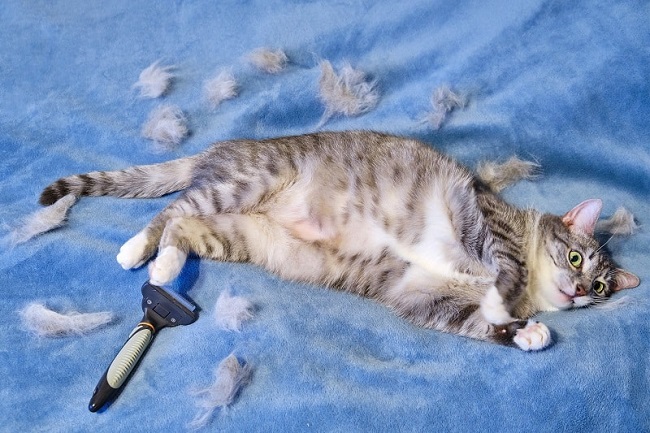
If you have ever had the pleasure of seeing newborn kittens, you may have noticed that they are not born “naked”, but they are, in fact, covered by very soft and short hair. Each of these hairs develops within and grows out of a tiny opening in the skin called a follicle. If you take a moment and look at your arm, you might be able to see that your hair is growing out of similar openings.
Believe it or not, a kitten is generally born with all the follicles he or she will ever have. This means that, although a kitten’s coat doesn’t look very much like the coat of an adult cat, both coats develop from the same follicles. Many hairs will grow from each of these follicles during the lifetime of a cat, and the characteristics of these hairs will vary as the needs of the animal change. A cat’s hair coat helps insulate the animal against cold and heat, provides a barrier against physical and chemical trauma to the skin, and offers protection from damaging sunlight.
Since our cats can’t simply remove a jacket when they are hot or put on a sweater when they are cold, their coats must be able to adapt to changing conditions. Each hair progresses through a three-stage life cycle, which includes a growing period, a transitional period, and a resting period. Once the hair has cycled through all three stages, it remains in the follicle as a dead hair until it is removed or “shed”. The length of each phase varies according to a cat’s age, breed, sex, and region of body, and it may be altered by several different factors.
The list of influencing factors is extensive and includes environmental temperature, nutrition, hormones and body chemicals, health status, and genetics. Research has demonstrated, however, that photoperiod (the daily amount of sunlight to which an animal is exposed) plays the most important role in determining the rate of hair replacement. An animal’s brain detects changes in sunlight patterns associated with changes in season and signals the hair follicles to respond in an appropriate manner.
Outdoor cats tend to shed more extensively for several weeks during major seasonal changes, particularly in the spring and fall, as the body modifies its hair coat in preparation for different climate conditions – cats grow more short, fluffy “secondary” hairs in the fall for added warmth, and subsequently shed this “undercoat” in the spring and replace it with longer, coarse “primary” hairs to help stay cool during warmer weather. Since our indoor cats are exposed to less natural sunlight and more “artificial” light, their bodies lose track of seasonal changes. As a result, they tend to shed in a relatively continuous fashion (much to the chagrin of owners) and do not experience the same fall and spring sheds which outdoor animals do.
It is important to realize, however, that regardless of whether an animal lives indoors or outdoors, shedding is a normal part of the hair life cycle and all cats continually shed dead hair from follicles and replace it with new hair. By providing your cat with proper nutrition, plenty of exercise, frequent grooming, and annual veterinary visits, you can help keep his or her hair coat healthy and may be able to minimize excessive shedding.
Provided by Eric Christensen, Cornell University College of Veterinary Medicine.
Related Articles & Free Email Newsletter Sign Up
A 13 Step Guide to Bathing a Cat
How to Understand Your Cat’s Behavior




Comment here